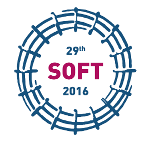Speaker
Pietro Arena
(Dipartimento di Energia)
Description
Within the framework of EUROfusion R&D activities CEA-Saclay has carried out an investigation of the thermal and mechanical performances of alternative designs intended to enhance the Tritium Breeding Ratio (TBR) of the Helium-Cooled Lithium Lead (HCLL) blanket for DEMO. Neutronic calculations performed on the 2014 DEMO HCLL layout have indeed predicted a value of TBR equal to 1.07, lower than the required value of 1.1, necessary to ensure the tritium self-sufficiency of the breeding blanket taking into account uncertainties.
In order to reach the TBR target, the strategy of the steel amount reduction inside the HCLL module breeding zone has been followed by suppressing some stiffening/cooling plates inside the BZ. Since all the plates inside the BZ are actively cooled by helium, each change in their geometric layout has a strong impact on the thermal response of the module. Moreover, the removal of stiffening plate may impact the resistance of the box in case of in-module’s loss of coolant.
In order to optimize from the thermal point of view the HCLL BZ layout, attention has been paid to the outboard equatorial module of the breeding blanket and the thermal behaviour of different geometric layouts of the elementary Breeding Unit has been assessed with the aim of checking that the thermal requirements foreseen for the EUROFER steel structural material are met while respecting acceptable pressure drops. Mechanical calculations have also been performed to analyse the behaviour of the module in faulted condition without full vertical stiffening plates.
To perform this research campaign a theoretical-numerical approach, based on the Finite Element Method (FEM), has been followed and the qualified Cast3m FEM code has been adopted.
Results obtained have been herewith presented and critically discussed, highlighting the open issues and suggesting the pertinent modifications to DEMO HCLL module design.
Co-authors
Alexandro Morin
(DEN, DM2S, CEA-Saclay, F-91191 Gif-Sur-Yvette, France)
Giacomo Aiello
(DEN, DM2S, CEA-Saclay, F-91191 Gif-Sur-Yvette, France)
Gilles Rampal
(DEN, DM2S, CEA-Saclay, F-91191 Gif-Sur-Yvette, France)
Jean-Charles Jaboulay
(DEN, DM2S, CEA-Saclay, F-91191 Gif-Sur-Yvette, France)
Julien Aubert
(DEN, DM2S, CEA-Saclay, F-91191 Gif-Sur-Yvette, France)
Pietro Alessandro Di Maio
(Dipartimento di Energia, Ingegneria dell'Informazione e Modelli Matematici, Università di Palermo, Viale delle Scienze, I-90128 Palermo, Italy)
Pietro Arena
(Dipartimento di Energia, Ingegneria dell'Informazione e Modelli Matematici, Università di Palermo, Viale delle Scienze, I-90128 Palermo, Italy)
Remi Boullon
(DEN, DM2S, CEA-Saclay, F-91191 Gif-Sur-Yvette, France)

